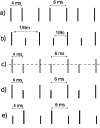Behavioral and physiological correlates of temporal pitch perception in electric and acoustic hearing
- PMID: 18247900
- PMCID: PMC2279014
- DOI: 10.1121/1.2821986
Behavioral and physiological correlates of temporal pitch perception in electric and acoustic hearing
Abstract
In the "4-6" condition of experiment 1, normal-hearing (NH) listeners compared the pitch of a bandpass-filtered pulse train, whose inter-pulse intervals (IPIs) alternated between 4 and 6 ms, to that of isochronous pulse trains. Consistent with previous results obtained at a lower signal level, the pitch of the 4-6 stimulus corresponded to that of an isochronous pulse train having a period of 5.7 ms-longer than the mean IPI of 5 ms. In other conditions the IPI alternated between 3.5-5.5 and 4.5-6.5 ms. Experiment 2 was similar but presented electric pulse trains to one channel of a cochlear implant. In both cases, as overall IPI increased, the pitch of the alternating-interval stimulus approached that of an isochronous train having a period equal to the mean IPI. Experiment 3 measured compound action potentials (CAPs) to alternating-interval stimuli in guinea pigs and in NH listeners. The CAPs to pulses occurring after 4-ms intervals were smaller than responses to pulses occurring after 6-ms intervals, resulting in a modulated pattern that was independent of overall level. The results are compared to the predictions of a simple model incorporating auditory-nerve (AN) refractoriness, and where pitch is estimated from first-order intervals in the AN response.
Figures








References
-
- Cariani PA, Delgutte B. Neural correlates of the pitch of complex tones. I. Pitch and pitch salience. J. Neurophysiol. 1996;76:1698–1716. - PubMed
-
- Carlyon RP. The effects of two temporal cues on pitch judgements. J. Acoust. Soc. Am. 1997;102:1097–1105.
-
- Carlyon RP. Temporal pitch mechanisms in acoustic and electric hearing. J. Acoust. Soc. Am. 2002;112:621–633. - PubMed
-
- Carlyon RP, Shamma S. An account of monaural phase sensitivity. J. Acoust. Soc. Am. 2003;114:333–348. - PubMed
-
- Carlyon RP, van Wieringen A, Long CJ, Deeks JM, Wouters J. Temporal pitch mechanisms in acoustic and electric hearing. J. Acoust. Soc. Am. 2002;112:621–633. - PubMed
Publication types
MeSH terms
Grants and funding
LinkOut - more resources
Full Text Sources
Medical
Miscellaneous

